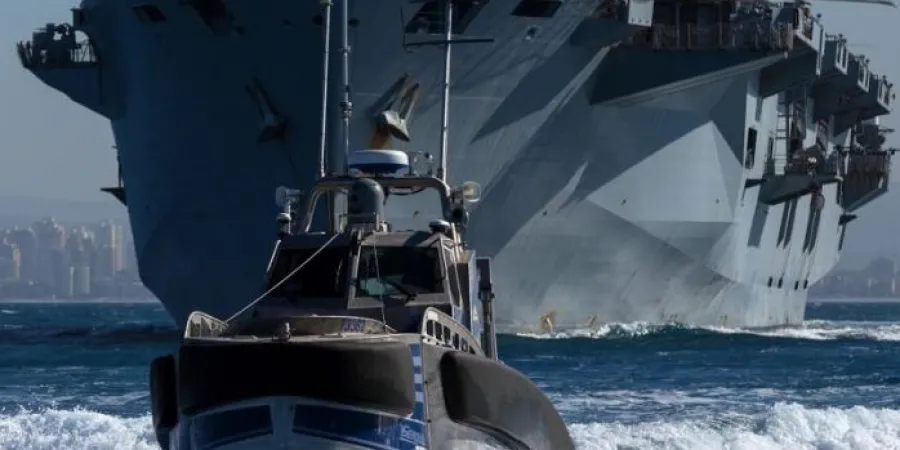Anti-Sub Warfare Capabilities of Elbit's Seagull Tested by British Gov't
The sea trials were conducted to examine how autonomous systems could support future operations of the British Royal Navy
IsraelDefense
| 10/06/2020
Elbit Systems UK said June 8 that its Seagull unmanned surface vehicle completed a series of Anti-Submarine Warfare (ASW) tests for the British Ministry of Defence.
The sea trials were carried out via the Defence Science and Technology Laboratory's Progeny Framework to explore how autonomous systems could support future ASW operations, the company said.
Elbit Systems UK was one of the shortlisted UK companies selected to take part in the second phase of the project, a series of trials that took place off the country's coast in late October 2019.
Elbit Systems UK used its Seagull unmanned surface vehicle (USV), with US company L3 Harris providing the sonar. The Seagull, Elbit System’s multi-mission, multi-sensor USV, demonstrated its autonomous ASW utility to the ministry during the entire testing period, utilizing its "ASW Toolbox" solution to show how the capabilities of the system offer a force multiplier for ASW operations, Elbit said.
Martin Fausset, CEO of Elbit Systems UK, said: “Elbit Systems has world leading technology to offer to the maritime and littoral environment. The Seagull USV has once again demonstrated its superior capabilities underlining Elbit Systems UK’s competitive position to providing innovative and cost-effective solutions to the UK Armed Forces. We are proud of our ongoing work with the Royal Navy as we work together to maintain its operational advantage.”
The Seagull USV has multi-mission capability, being able to perform anti-submarine warfare (ASW), Mine Counter Measures (MCM), electronic warfare, maritime security, hydrography and other missions using the same vessels, mission control system and data links, according to the company.
Elbit said the drone ship's ASW capability provides the navy with a tactical advantage by deterring and threatening enemy submarines using an asset with significantly lower risk, while the Seagull’s MCM capability facilitates end-to-end mine hunting operations including detection, classification, localization, identification and neutralization of bottom, moored and drifting sea mines.
The sea trials were conducted to examine how autonomous systems could support future operations of the British Royal Navy
Elbit Systems UK said June 8 that its Seagull unmanned surface vehicle completed a series of Anti-Submarine Warfare (ASW) tests for the British Ministry of Defence.
The sea trials were carried out via the Defence Science and Technology Laboratory's Progeny Framework to explore how autonomous systems could support future ASW operations, the company said.
Elbit Systems UK was one of the shortlisted UK companies selected to take part in the second phase of the project, a series of trials that took place off the country's coast in late October 2019.
Elbit Systems UK used its Seagull unmanned surface vehicle (USV), with US company L3 Harris providing the sonar. The Seagull, Elbit System’s multi-mission, multi-sensor USV, demonstrated its autonomous ASW utility to the ministry during the entire testing period, utilizing its "ASW Toolbox" solution to show how the capabilities of the system offer a force multiplier for ASW operations, Elbit said.
Martin Fausset, CEO of Elbit Systems UK, said: “Elbit Systems has world leading technology to offer to the maritime and littoral environment. The Seagull USV has once again demonstrated its superior capabilities underlining Elbit Systems UK’s competitive position to providing innovative and cost-effective solutions to the UK Armed Forces. We are proud of our ongoing work with the Royal Navy as we work together to maintain its operational advantage.”
The Seagull USV has multi-mission capability, being able to perform anti-submarine warfare (ASW), Mine Counter Measures (MCM), electronic warfare, maritime security, hydrography and other missions using the same vessels, mission control system and data links, according to the company.
Elbit said the drone ship's ASW capability provides the navy with a tactical advantage by deterring and threatening enemy submarines using an asset with significantly lower risk, while the Seagull’s MCM capability facilitates end-to-end mine hunting operations including detection, classification, localization, identification and neutralization of bottom, moored and drifting sea mines.



